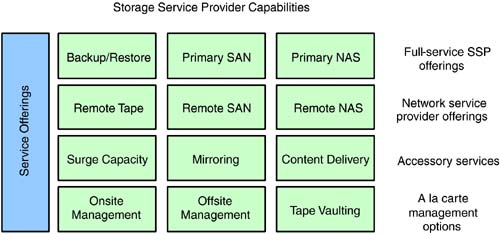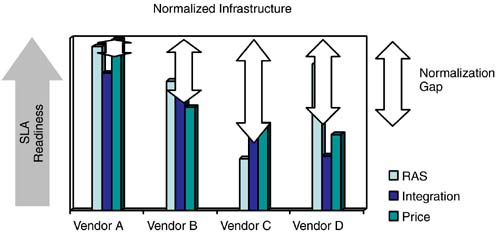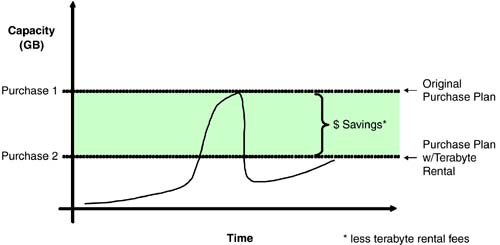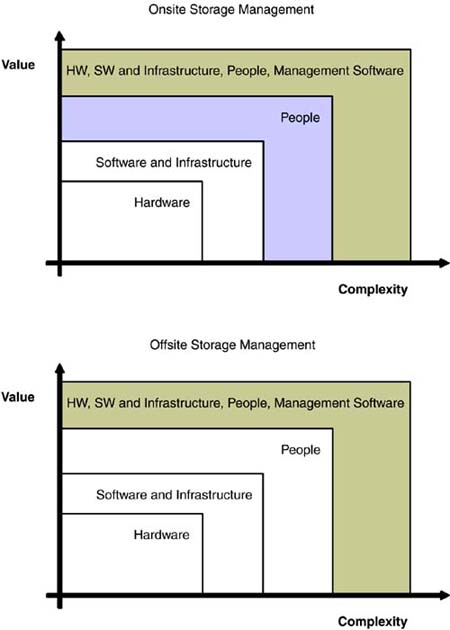7.1 Outsourced Storage
| Cheaper, faster, better. This is the typical mantra of the general outsourcing market and represents the overall business solution and value proposition. In reality, there is nothing different when it comes down to storage outsourcing. However, outsourcing is not always a "one size fits all" solution. The most value created by storage outsourcing ”or by outsourcing in general, for that matter ”comes when the complexity of the solution outstrips the knowledge base of inhouse staff. Thus, as complexity increases , so does both the real and perceived value. Figure 7-1 illustrates the relationship between complexity and value for storage functions within an organization. The functional specifics have been detailed in the previous chapters. Simply putting the pieces of the networked storage solution together, from a hardware perspective, is relatively straightforward and well documented throughout the industry. Administrators can choose either SAN or NAS, or can combine the two. Choosing RAID arrays is an age-old practice that does not create much strain on the average enterprise IT staff. Thus, the perceived value is quite low for the ability to accomplish those tasks . However, when bundled with the required software, networking, and infrastructure, the task becomes more complex. Here is a list of some of the questions that arise during this phase:
Figure 7-1. Increases in complexity of solution create value and need for outsourcing. Increasing the level of complexity to include people management adds additional challenges, compounding those already present. Enterprise networked storage teams grapple with the issue of hiring, training, and retaining storage talent. Additionally, the uniqueness of large-scale deployments creates a need to retain staff-centric intellectual assets. But, as the IT staff grows and gains incremental knowledge, its worth may exceed the firm's ability to compensate and retain this talent. The "people" challenge is like fighting a two-front war for most CIOs. Putting the right pieces of the technology puzzle together is difficult enough, but also trying to juggle scarce human resources can drive IT managers to the brink. Try putting it all together and also adding event and problem management. For large companies, this is the complexity peak of networked storage deployments. The introduction of event management has a ripple effect through all other areas: hardware, software, infrastructure, and people. More questions follow that the IT staff must answer:
Compiling these pieces of the puzzle can easily lead to outsourcing. After all, outsourcing is a natural extension of corporate IT frustration and the inability to achieve defined goals and core business requirements from information systems. As we discuss the different flavors of storage outsourcing, we use these frameworks as a means to explore the pros and cons of each solution and where it may or may not fit within a particular organizational construct. 7.1.1 Storage Service ProvidersStorage service providers (SSPs) offer a variety of outsourced storage services. These services have come in many different flavors and as many different forms over the past several years . However, at the core, these new entities sell and deliver very similar products and services. Examining what a full-service SSP offers and the operational agility value created, we will answer the following questions:
7.1.2 SSP CapabilitiesThe SSP business model is built on the premise that through scale and operational best practices, the service provider can offer a greater degree of service at a lower cost than a single enterprise could do independently. This section dissects the operational components of the SSP business model to provide insight into key considerations for a partnership with an SSP. To serve the market, full-service SSPs must build a set of capabilities that mimic typical enterprise activities conducted with storage-focused IT staff. Figure 7-2 illustrates the specific capabilities required to offer a complete bundle of services. The key is that no SSP can offer any enterprise operational agility or flexibility within its storage-computing environment unless the SSP can offer exactly the same functionality within its service. Figure 7-2. Service offerings for storage and network service providers. The need to replicate user environment services stems from the diversity of the following enterprise storage pieces:
Enterprise computing environments are largely unique, but most use similar technology to solve different business needs. For example, one company might use clustering software as a means to create availability, while another may use the same piece of software for load sharing. Thus, the storage environment must be configured differently in each scenario to account for the alternative architectures. In the first example, only one host is talking to storage at any single point in time, while in the second example both hosts are interacting with the storage and may require different volume creations and potentially different physical disk allocations . The SLA is the heart and soul of any SSP. An entire set of practices and principles guides the service provider on a daily basis and drives value and agility back to customers and end users. The specifics of effective, ongoing SLA management are covered in Section 7.3. We begin here by defining the core components that make up the SLA and allow the service provider to successfully deploy various storage services and configurations while maintaining SLA adherence. These core components include the following considerations for SSPs:
7.1.3 Closing the Normalized Infrastructure GapSSPs use value-added storage management software to differentiate their capabilities and provide a feature/function set at a lower cost point than companies could do independently. Normalizing the infrastructure of vendor equipment, specifically hardware, and bringing the end-service offering to an acceptable level of SLA readiness occurs by filling the normalization gap, as shown in Figure 7-3. Figure 7-3. The effect of storage management software on the deployed infrastructure. Closing the normalization gap applies to SSPs looking to provide customer SLAs and also enterprise customers creating internal SLAs for departments. Each vendor is ranked on attributes such as reliability, availability, and serviceability (RAS), software integration and reporting capabilities, and price. To go from a weighted average of these attributes to full SLA readiness, SSPs and enterprises must provide the appropriate storage management software and management oversight. Having identified the base set of capabilities, we turn our attention to the various types of SSPs and focus on the services and offerings mentioned previously. The following section breaks apart the various offerings and unlocks the mysteries of the storage service delivery model. 7.1.4 Complete OutsourcingFact: When most companies need electrical power, they do not go and build a generator plant. These companies buy electricity delivered over wires from a centralized facility that services many customers in the same region at the same point in time. The fully outsourced IT delivery model is a tried and true practice. Companies such as EDS and IBM Global Services have delivered on thousands of contracts for outsourced IT services and will continue to do so for the foreseeable future. Companies like these have found the right place in the IT market, where scale, complexity, and value intersect. For some of the largest enterprise computing environments and for highly specialized applications, the fully outsourced contract provides the maximum degree of operational flexibility and organizational agility. Companies contracting EDS-like services long ago discovered that the ongoing cost of building the solution themselves was not a required core capability. The same reasoning applies to many companies outsourcing the operations of their data center or their call center. In their minds, the cost and complexity of achieving the required results creates a drag on the company from either an expense or a mindshare perspective. Because many IT shops often lack some key expertise, the contracting firm turns to outsourcing because it is the only way to get the job done right. The same set of market conditions created the need for storage to be delivered as a service. More and more businesses conduct commerce electronically and rely heavily on Web-enabled applications, creating a surging demand for data storage capacity. As storage growth reached exponential levels, a cry could be heard from enterprise data centers for relief and the return to sanity . Thus, storage itself reached the intersection of complexity, scale, and value. The scale of the growth combined with compounding complexity matched the market-attributed value of storage services. Another factor leading to the need to for fully outsourced solutions was a severe knowledge gap with the emerging networked storage solutions. Most IT organizations know about the efficiencies and ease of management of networked storage, but have no knowledge of how to implement these solutions. Common questions among an untrained IT staff might include these:
A question CIOs often ask when considering an outsourced storage model is, "So, what do I really get with this service, and what are my options?" Now that we understand the reason behind the fully outsourced storage model, let us turn our attention to dissecting the specific components of each offering. 7.1.5 Complete Outsourcing: Core Service OfferingsPrimary Storage Area Network (SAN) . The SAN service consists of the delivery of block-level storage access from a predefined set of hosts across a Fibre Channel fabric. Hosts are allocated storage volumes and capacity. Often, a minimum capacity amount is contracted from the provider and additional capacity added at the customer's request. The line of demarcation typically resides at the host connection to the Fibre Channel network access, but does not include the actual HBAs. The service provider monitors the environment for problems and reacts to events up to and including the HBA. Depending on the service provider or the specific contract, the storage array is a shared resource, and each customer has access rights to specific ports on the array (this mitigates much of the security risks associated with array sharing). Service metrics include
Primary Network-Attached Storage (NAS) . The NAS service includes file-level access to a predefined storage capacity connected to specialized file servers. A customer connects with this service through a Gigabit Ethernet network delivered from the service provider. Typically, this consists of dual gigabit connections from the network delivered to a customer aggregation point. The aggregation point is where the customer has its hosts connected to an internally run network. The line of demarcation is the point at which the dual gigabit connections attach to the customer network. Dual paths and clustered file servers are used for increased service level availability. In most cases the file server and disk storage infrastructure are dedicated to each customer to mitigate security concerns and IP addressing conflicts. The service provider typically monitors the environment for network congestions, storage availability, and file server health. Service metrics include
Backup and Restore . The backup and restore service consists of the successful transfer of data from predefined host servers to a shared tape library infrastructure. The actual tape cartridges are dedicated to each customer, but the network, library, catalog disk, and backup servers are shared resources. A typical configuration for this service includes the creation of a dedicated Ethernet network (various speeds depending on throughput requirements) on the customer side and a set of Gigabit Ethernet connections to the shared backup network of the service provider. The service provider then passes that traffic along its shared Ethernet network through the backup server and writes the data to the tape within the library. Additionally, the service provider provides and configures all software required to initiate, schedule, complete, and report on the progress of backup jobs. This includes the configuration of database servers and file systems alike. Typically, the service provider commits to initiating and completing the backup job within a set time frame. The service provider is expected to monitor the status of all jobs to ensure proper completion within the window. Also, the service provider is expected to restart any failed or stalled job to comply with the backup window timeframe. Finally, the service provider delivers a success/failure report to the customer at the completion of all backup windows for all jobs, providing visibility into the health and welfare of the corporate assets. Service metrics include
Remote SAN . The remote SAN service consists of the same components found in the primary SAN storage service with a couple of key additions. The service provider delivers wide-area or metro-area connections to the back-end storage infrastructure from the customer location, while also providing and configuring any software required to execute the remote read/write functions of the host disk interaction. Note that this service has been implemented primarily as a disaster protection solution for many companies but rarely used as a solution for primary storage access. High network costs and latency at distances greater than 10 km prevent anything but high-interval, asynchronous connections to the remote storage repository. Service metrics include
Remote NAS . The remote NAS service consists of all the same components found in the primary SAN storage service with a couple of key additions. The service provider also delivers wide-area or metro-area connections to the back-end storage infrastructure from the customer location, while also providing and configuring any software required to execute the remote read/ write functions of the host disk interaction. Service metrics include
Remote Tape Backup and Restore . The remote tape service contains many components similar to the local backup and restore service, with a couple of key additions. Obviously, wide-area or metro-area network connections are required for this service. Also, the service includes the use of media servers to increase the data streaming rate and maximize the write speeds on drives, reducing overall system latency. The line of demarcation remains the same but includes the additional network component. Service metrics include
Content Delivery . The content delivery service consists of the creation of read-only storage nodes that locate specific data in geographic proximity to potential end users. This is exclusively a file-level service, and the underlying infrastructure relies on standard file-serving NAS technology. This service is the most esoteric of all of the fully managed storage services and is usually implemented by large media outlets requiring massive amounts of continually replicated data. The read-only nature of the data source allows centralized data dispersal to remote geographies and guarantees uniform access by all end users. Service metrics include
The complete SSP outsourcing option provides a turnkey solution for IT organizations struggling to create value through independent storage and infrastructure management. From an operational perspective, the SSP assesses the business requirements, architects a unique solution, creates the design specifications for the storage infrastructure, implements the prescribed solution, provides ongoing management, and delivers with service-level guarantees. This allows the IT staff to focus on more important projects core to the company's business, potentially with more direct revenue impact. Additionally, this preserves cash by deferring purchases of expensive storage and networking equipment. Finally, the solution meets requirements without extensive lab trials, technology research, vendor bake-offs, and risky decisions. All of these tasks and solutions provide a more flexible computing framework to drive value to the agile organization. 7.1.6 Terabyte RentalIT organizations often need deep pools of storage capacity for a brief period of time. This need may be due to data migration requiring a staging area during the transfer or for surge capacity during a sales promotion for an online retailer. The typical response is to purchase and provision the excess capacity in advance of the need and allocate the space as required. Obviously, the business's needs should be the first and foremost consideration. If the business unit needs the capacity, then the IT staff is compelled to make it available, assuming there is a supporting business case. However, this creates inefficiencies in capacity management and can cause the company to procure and deploy excess capacity that would not be needed in the normal growth of the core storage assets. Adding capacity uses valuable capital, may decrease future lease options, and creates an investment in dated technology. Since excess core capacity is deployed early to meet a short-term surge, using that capacity at a later date for core requirements makes it dated by default. With the pace of development and innovation in the storage sector, such a proposition sets any IT organization up for potentially incremental investments later on to adjust the match between core requirements and available assets. Figure 7-4 illustrates the overprovisioning of capacity to meet short- term surge requirements. In this case, incorporating terabyte rental allows Purchase 2 to meet current needs while avoiding the higher expense of Purchase 1. Figure 7-4. The effect of provisioning capacity to meet short-term capacity requirements. Many SSPs offer an elegant solution to this problem that IT organizations face. Companies can rent capacity on a short-term basis to solve business needs while not interfering with normal deployment and growth of the core data center storage assets. This solution may require high-speed network connections or may depend on the nature of the applications slated for the collocation facility. However, this solution protects the company from vendor and technology lock-in while preserving cash and allowing the IT staff to focus on core business requirements. 7.1.7 Storage Management OffsiteOffsite storage management is a way for organizations to take advantage of the SSP's expertise and management capabilities while retaining control and decision making for hardware deployment and physical disk requirements. SSPs offer best practices and remote monitoring capabilities to enable IT organizations to act like an internal service provider to their business units. The SSP provides the company with detailed configuration and design requirements along with a supporting bill of material (BOM). This creates an optimal infrastructure design for the IT organization and allows the SSP to effectively accomplish monitoring and event management tasks. Internal IT teams create service levels around provisioned storage and implement effective charge-back scenarios, transforming the data center from a cost center to a value center. This service applies to SAN, NAS, and backup/restore configurations. The key to this service is provision of configuration details and procurement requirements, which frees the IT staff to focus on the level-one management tasks and develop solutions to the more complex challenges. The remote monitoring, event management, and reporting capabilities are often too complex for most IT shops and require deep-seated knowledge along with extensive coding and scripting. For most companies, the scale of their storage assets does not warrant this level of initial investment and ongoing commitment. Thus, the SSP allows the company to deliver a solution internally while maintaining flexibility at a lower cost than it would if the company decided to do it on its own. Figure 7-5 creates a useful comparison between the offsite and onsite management solutions. Figure 7-5. A comparison of the activities between onsite and offsite storage management. Typical service configurations include a series of monthly host connection fees as well as monthly capacity under management fees. 7.1.8 Storage Management OnsiteOnsite storage management is similar to the offsite service, but in this case the SSP also provides the people to perform the daily storage infrastructure management. While the company still procures and maintains ownership of the storage hardware and physical disk array systems, the SSP staff performs the day-in and day-out tasks of storage management. The customer still purchases and deploys storage based on the prescribed configurations set forth by the SSP and continues to use the SSP's expert design services and resident knowledge. This removes the need to invest deeply in internal subject matter expertise. The most compelling reason to incorporate this service into data center designs is the reduction of the workforce-carrying costs. Storage expertise can be a significant human resource expenditure that can be dramatically reduced or eliminated. On the flip side, companies must be careful not to eliminate resident storage skills entirely. Without inhouse knowledge of storage, companies risk vendor lock-in, ultimately reducing their deployment options. Figure 7-5 details the differences between the offsite and onsite management options offered by SSPs. The colored areas are where the SSP would perform the activities. |
EAN: 2147483647
Pages: 108




